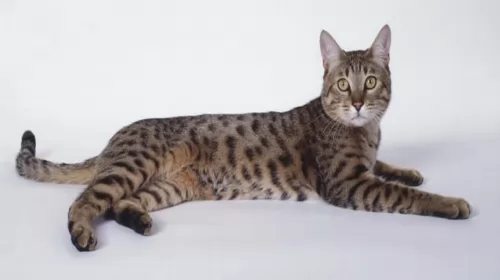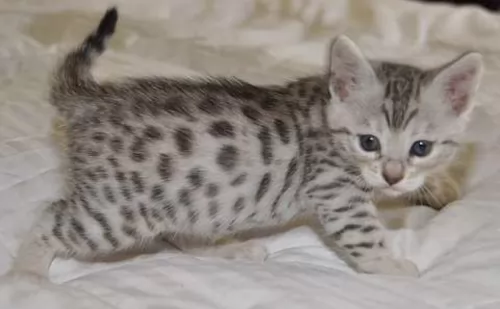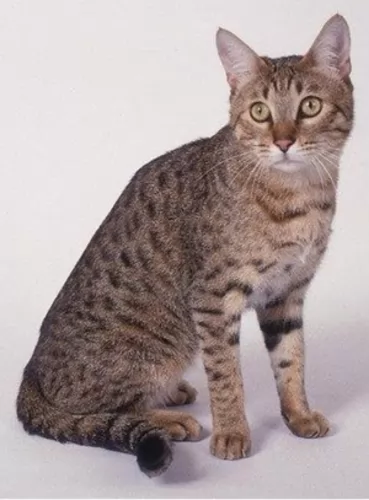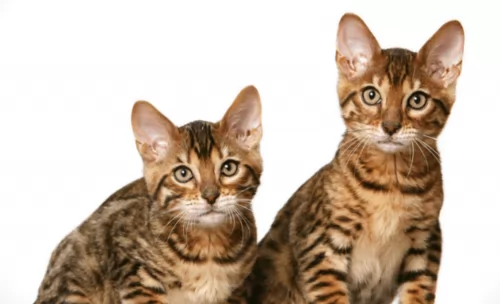 Petzlover
Petzlover Both California Spangled Cat and Oriental Bicolour are originated from United States. Both California Spangled Cat and Oriental Bicolour are having almost same weight. Both California Spangled Cat and Oriental Bicolour has same life span. Both California Spangled Cat and Oriental Bicolour has same litter size. California Spangled Cat requires Moderate Maintenance. But Oriental Bicolour requires Low Maintenance
Both California Spangled Cat and Oriental Bicolour are originated from United States. Both California Spangled Cat and Oriental Bicolour are having almost same weight. Both California Spangled Cat and Oriental Bicolour has same life span. Both California Spangled Cat and Oriental Bicolour has same litter size. California Spangled Cat requires Moderate Maintenance. But Oriental Bicolour requires Low Maintenance
 People seem to want a cat that resembles some of the wild cats we have, and the California Spangled is a domestic cat that has been bred to resemble spotted wild cats.
People seem to want a cat that resembles some of the wild cats we have, and the California Spangled is a domestic cat that has been bred to resemble spotted wild cats.
In fact, it was during the 1970s, that Paul Casey, an American scientist, returned from Tanzania to create a cat breed that resembled a wild cat such as a leopard.
There are many breeds that make up the California Spangled cat and these are the Abyssinian, British Shorthair, Siamese as well as some stray cats. Today, the breed has all but disappeared and there are only a few of the cats left.
 Oriental Bicolour cats owe their origins to Lindajean Grillo of Ciara Cattery. The cats hail from the United States. It was in 1979 that Grillo paired a Siamese and bicolored American Shorthair, selecting the best bicolored offspring to mate again with Siamese or Orientals.
Oriental Bicolour cats owe their origins to Lindajean Grillo of Ciara Cattery. The cats hail from the United States. It was in 1979 that Grillo paired a Siamese and bicolored American Shorthair, selecting the best bicolored offspring to mate again with Siamese or Orientals.
This particular variety was granted recognition in 1983 by TICA. It was during the 1980s that European breeders started their own Oriental bicolor breeding lines. The first modern Oriental Bicolours were imported to the UK during 2004.
 The California Spangled cat is lean with a long muscular body and long legs. Its long body makes it look like it is on the prowl like a leopard.
The California Spangled cat is lean with a long muscular body and long legs. Its long body makes it look like it is on the prowl like a leopard.
Its coat, similar to that of a leopard, can be a mix of colors such as black, tan, silver, red and white with a mix of different shaped spots. The coat is fairly short and doesn’t require too much grooming. However, a brush will be like a bonding session for you and your cat and it will keep his coat shiny and free of loose hairs and dust.
The cat has almond-shaped eyes that are amber to copper-colored.
This cat is independent but it still wants to get a lot of attention from his owners. They’re affectionate, social and devoted to their human family. They are known for their intelligence and high energy levels, enjoying games that involve lots of action and participation.
Being an active cat, it needs a lot of space to roam and to play. Because he is smart, buy him interesting toys, a scratching post, and climbing equipment.
 These cats with a triangular-shaped head and slender, long body have a fairly thin tail. The ears are widely set and are large. The eyes are green, but blue with the colorpoint varieties.
These cats with a triangular-shaped head and slender, long body have a fairly thin tail. The ears are widely set and are large. The eyes are green, but blue with the colorpoint varieties.
The coat is short, close-lying and sleek while the coat of the long-haired variety is fine and silky with no thick undercoat. The tail forms a plume. The coat is mostly white and the other part of the coat can be in any other color. You’ll always see quite a bit of white around the legs.
These cats are suited for singles, couples, families, and seniors - in fact, anyone still active enough to provide this cat with lots of attention.
These vibrant cats are known for their social, friendly and loving personality. They are intelligent, inquisitive, active cats that need to have plenty of interaction with their human family members. They love their human family and love to hold conversations with them.
They're entertaining too, and love nothing more to ve the center of attention. They're so into their human family that you may even have him waiting patiently for you to come home fro work. He shouldn't be left alone for hours on end and should rather have a pet friend to keep him company during the day.
 These active but calm cats are very sociable, liking to talk to only when needed and then the meow of the cat is soft.
These active but calm cats are very sociable, liking to talk to only when needed and then the meow of the cat is soft.
While this cat would prefer being the only cat in the family, they are quite adaptable in the right environment and will adapt to a home where there are other pets.
These are cats that enjoy being the only cat in the house, but they are prepared to adapt to a life shared wth other cats or dogs.
They love playing and will respond well to children who have been taught how to be kind to animals.
They’re pricey cats these but they can certainly provide you with 15 years of great companionship.
 The Oriental Bicolor is such a wonderful pet to have. They are intelligent, entertaining, loving, active, playful, and inquisitive.
The Oriental Bicolor is such a wonderful pet to have. They are intelligent, entertaining, loving, active, playful, and inquisitive.
They’re also athletic and energetic. These cats have got all the characteristics you want in a good friend. They make a fantastic companion to people who are active and happy. They’re also very vocal and have a lot to say to their human family.
 Any cat can develop health problems. Even kittens that come with a certificate of health can develop illnesses that you never thought possible.
Any cat can develop health problems. Even kittens that come with a certificate of health can develop illnesses that you never thought possible.
Orientals are generally healthy cats, but the health issues that may affect the Oriental are similar to that of the Siamese cat.
One of these is Progressive Retinal Atrophy (PRA). This is a genetic eye problem that can lead to blindness. Another disease to look out for is Asthma. The Siamese is susceptible to this disease which means your Oriental Bicolor will also be. You will have to get your furry friend to the vet who may precribe anti-inflammatory drugs.
 When it comes to feeding these cats, you’ll find that the California Spangled Cat is highly energetic and therefore his food needs to be of the very best high protein that there is.
When it comes to feeding these cats, you’ll find that the California Spangled Cat is highly energetic and therefore his food needs to be of the very best high protein that there is.
The cat requires high-quality food and food that is adapted to his growth and energy levels. If your California Spangled Cat had to hunt for his own food it would be mice and birds - protein.
In your home, he’ll need cat food high in protein. A diet deficient in protein can lead to all kinds of health issues. The reason for this is the protein has amino acids and this plays many essential roles in the body, strengthening the immune system.
Fortunately, in our busy world, commercially manufactured cat foods from top brands are nutritionally complete and balanced, and they’re high-protein cat foods. Proteins are imperative for the functioning of all body parts, and nursing queens for instance may well need more protein to get the kittens off to a good start.
Your California Spangled cat isn’t a huge shedder so a regular brushing once a week of the short coat will get rid of dust and loose hairs.
They’re playful cats these so provide them with games and toys that can help with using up some of this energy.
 The Oriental Bicolor will require a brushing once a week. A good idea is to also take a warm, damp cloth and to wipe your cat down. It’s an excellent way to rid your cat of loose hairs as well as dust. The cat has a sparse coat, so brush him gently.
The Oriental Bicolor will require a brushing once a week. A good idea is to also take a warm, damp cloth and to wipe your cat down. It’s an excellent way to rid your cat of loose hairs as well as dust. The cat has a sparse coat, so brush him gently.
Other grooming requires nail clipping and checking inside his ears. If you clean his ears, be careful not to go deep into the ear. It is precisely why so many cat owners take their cat to the pet groomers where they can do these things professionally.
It’s very important to keep your Bicolor’s litter box spotlessly clean because like most cats, they won’t use their litterbox if it’s still got yesterday’s feces in it. It needs to be cleaned every day.
The Oriental’s diet is much like that of other cats – it has to be meaty. You can’t afford to not understand your feline pet’s dietary needs. Cats are carnivorous and they need commercial cat food that will be equal to fresh meat that they would normally find in the wild.
They need foods high in protein but they will still need some carbohydrates, amino acids, and vitamins, and minerals. Always go for the best quality pet cat foods because by buying the poorer quality ones you put your cat at risk of developing health problems. Never ever leave your cat without a constant supply of fresh, cool drinking water.
Supply your cat with all the things that make it a pleasure to have a cat. You don’t want to bring your pet home and only then start looking for things to make him at home. He’ll need food and water bowls, a nice warm, soft bed, a litter box, grooming accessories, collar, toys climbing tree and scratching pole.
Have your pet neutered or spayed to prevent unwanted kittens.
Make sure he is taken to the vet when ill. You shouldn't own a pet if you can't afford to pay vet fees. There are some cat illnesses that can make your cat very sick and uncomfortable. He should have his vaccines and also be treated for parasites.